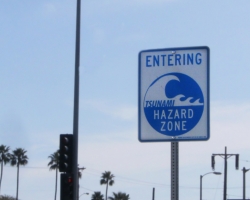The massive 9.0 earthquake off the eastern coast of Japan last Friday generated an immense tsunami that devastated the country’s northeast coast, and sent dozens of countries in and around the Pacific Ocean scrambling to prepare their coastlines for an imminent tsunami inundation.
A tsunami warning was issued for Northern and Central California, leading to widespread evacuations from coastal areas. A lesser tsunami advisory was placed on Southern California, resulting in closed beaches but no evacuations. Los Angeles’s Westside was not expected to suffer widespread damage, but disaster service workers were not taking any chances.
Scott Affa, a film student in Santa Monica and volunteer disaster worker for the city of Los Angeles, received a call early Friday morning informing him of the tsunami threat.
“I just heard that there was a tsunami coming and if they’re really telling me to get up at 3 a.m., I’m thinking, ‘OK, maybe this might be real,’” he said.
Affa, who is also trained as a lifeguard, is part of a growing group of amateur (ham) radio operators who volunteer for the county during disaster situations, providing vital communication links when conventional methods fail or are unavailable. He is responsible for placing a mobile repeater station in a convenient area for emergency communications. Last Friday, he parked his truck full of emergency gear on a hill near the Getty Center and waited for further instructions. While he kept watch on a hilltop, other operators and emergency workers were on standby at fire stations, police departments and city halls.
“If communications were knocked out or if everyone starting using their phones and jammed the cell towers, I would have continued to The Grapevine [the pass through the Tehachapi Mountains on Interstate 5], and the mobile repeater station in my truck would have allowed us to [communicate] from the South Bay as far as Sacramento and even to Las Vegas,” Affa said. “I’m basically taking a signal from the lower basin of L.A. County and throwing it over the mountains to wherever it needs to go.”
When the tsunami finally arrived in Santa Monica about 8:30 a.m. Friday, the waves were not large and destructive like those which destroyed cities and towns in Japan, but the strong one- to three-foot tidal surges still caused damage to ports and harbors in Oregon and Northern California. The surges did little to no damage to the Westside beach communities. Footage from news helicopters and amateur video shows the waves surging through Marina del Rey, rattling small boats and causing Ballona Creek to flow backward for a brief period of time.
As local residents let out a sigh of relief, Affa and other emergency workers calmly wrapped up their duties and went about their day, glad to have been spared disaster. “I was a bit nervous,” he said, adding that, ultimately, he still had a job to do in spite of it.

